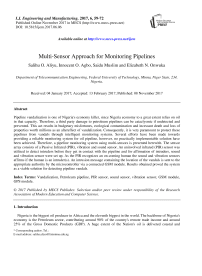Multi-Sensor Approach for Monitoring Pipelines
Автор: Salihu O. Aliyu, Innocent O. Agbo, Saidu Muslim, Elizabeth N. Onwuka
Журнал: International Journal of Engineering and Manufacturing(IJEM) @ijem
Статья в выпуске: 6 vol.7, 2017 года.
Бесплатный доступ
Pipeline vandalization is one of Nigeria's economy killer, since Nigeria economy to a great extent relies on oil in that capacity. Therefore, a third party damage to petroleum pipelines can be cataclysmic if undetected and prevented. This act results in budgetary misfortunes, ecological contamination and incessant death and loss of properties worth millions as an aftereffect of vandalization. Consequently, it is very paramount to protect these pipelines from vandals through intelligent monitoring systems. Several efforts have been made towards providing a reliable monitoring system for oil pipeline, however, no practically implementable solution have been achieved. Therefore, a pipeline monitoring system using multi-sensors is presented herewith. The sensor array consists of a Passive Infrared (PIR), vibration and sound sensor. An uninvolved infrared (PIR) sensor was utilized to detect intruders before they get in contact with the pipeline and for affirmation of intruders, sound and vibration sensor were set up. As the PIR recognizes an on-coming human the sound and vibration sensors affirms if the human is an intruder(s). An intrusion message containing the location of the vandals is sent to the appropriate authority by the microcontroller via a connected GSM module. Results obtained proved the system as a viable solution for detecting pipeline vandals.
Vandalization, Petroleum pipeline, PIR sensor, sound sensor, vibration sensor, GSM module, GPS module
Короткий адрес: https://sciup.org/15014461
IDR: 15014461
Список литературы Multi-Sensor Approach for Monitoring Pipelines
- PM News, “Nigeria loses N470m daily to pipeline vandalism,” 2016. [Online]. Available: http://www.news24.com.ng/National/News/nigeria-loses-n470m-daily-to-pipeline-vandalism-20160120. [Accessed: 24-Apr-2016].
- O. Shoewu, L. A. Akinyemi, K. A. Ayanlowo, S. O. Olatinwo, and N. T. Makanjuola, “Development of a Microcontroller Based Alarm System for Pipeline Vandals Detection,” J. Sci. Eng., vol. 1, pp. 133–142, 2013.
- F. C. Obodoeze, “Wireless Sensor Network in Niger Delta Oil and Gas Field Monitoring: The Security Challenges and Countermeasures,” Int. J. Distrib. Parallel Syst., vol. 3, no. 6, pp. 65–77, 2012.
- I. Abraham, “Designing an Intelligent Microcontroller based Pipeline Monitoring System with Alarm , Sensor,” vol. 3, no. 2, pp. 22–27, 2015.
- V. O. S. Olunloyo, A. M. Ajofoyinbo, and A. Yaba, “A model for real time leakage detection in pipelines : A case of an integrated GPS receiver.”
- K. F. K. Oyedeko and P. Engineering, “Modeling and Simulation of a Leak Detection for Oil and Gas Pipelines via Transient Model : A Case Study of the Niger Delta,” vol. 5, no. 1, pp. 16–28, 2015.
- Z. Yang, “Research on Leakage Detection and Analysis of Leakage Point in the Gas Pipeline System,” Open J. Saf. Sci. Technol., vol. 1, no. 3, pp. 94–100, 2011.
- G. N. Ezeh, N. Chukwuchekwa, J. C. Ojiaku, and E. Ekeanyawu, “Pipeline Vandalisation Detection Alert with Sms,” vol. 4, no. 4, pp. 21–25, 2014.
- T. Chis and A. Saguna, “Pipeline Leak Detection Techniques,” Ann. Comput. Sci. Ser. 5th Tome 1st Fasc., pp. 25–34.
- N. F. Henry and O. N. Henry, “Wireless Sensor Networks based Pipeline Vandalisation and Oil Spillage Monitoring and Detection: Main Benefits for Nigeria Oil and Gas Sectors,” vol. 3, no. 1, pp. 1–7, 2015.
- A. Azubogu, V. Idigo, S. Nnebe, and O. Oguejiofor, “Wireless Sensor Networks for Long Distance Pipeline Monitoring,” Waset.Org, vol. 7, no. 3, pp. 86–91, 2013.
- H. Zhang, F. Zhang, Y. Wang, and G. Zhang, “Wireless Sensor Network based anti-theft system of monitoring on petroleum pipeline,” 2011 2nd Int. Conf. Mech. Autom. Control Eng. MACE 2011 - Proc., pp. 4689–4692, 2011.
- Z. Chen, M. Temitayo, and P. D. Isa, “Pipe Flaws Detection by Using the Mindstorm Robot,” vol. 2, no. 6, pp. 569–574, 2012.
- G. C. Ononiwu, P. U. Eze, O. J. Onojo, G. N. Ezeh, D. O. Dike, S. I. Igbojiaku, and O. C. Nnodi, “A Real-Time Oil Pipeline Anti-Intrusion System Using Acoustic Sensors,” vol. 4, no. 26, pp. 3740–3756, 2014.
- S. Choi, B. Song, R. Ha, and H. Cha, “Energy-aware pipeline monitoring system using piezoelectric sensor,” IEEE Sens. J., vol. 12, no. 6, pp. 1695–1702, 2012.
- N. Mohamed and I. Jawhar, “A fault tolerant wired/wireless sensor network architecture for monitoring pipeline infrastructures,” Proc. - 2nd Int. Conf. Sens. Technol. Appl., SENSORCOMM 2008, Incl. MESH 2008 Conf. Mesh Networks; ENOPT 2008 Energy Optim. Wirel. Sensors Networks, UNWAT 2008 Under Water Sensors Syst., pp. 179–184, 2008.
- L. Qiu, K. I. Wang, and Z. Salcic, “Dynamic Duty Cycle-based Wireless Sensor Network for Underground Pipeline Monitoring,” pp. 116–121, 2015.
- H. Saeed, S. Ali, S. Rashid, S. Qaisar, and E. Felemban, “Reliable monitoring of oil and gas pipelines using wireless sensor network (WSN) — REMONG,” 2014 9th Int. Conf. Syst. Syst. Eng., pp. 230–235, 2014.
- R. B. Santos, E. O. De Sousa, F. V. Da Silva, S. L. Da Cruz, and a. M. F. Fileti, “Real-Time Monitoring of Gas Pipeline through Artificial Neural Networks,” 2013 BRICS Congr. Comput. Intell. 11th Brazilian Congr. Comput. Intell., pp. 329–334, 2013.
- J. Sun and J. Wen, “Research on monitoring and pre-warning system for security of pipelines based on multi-seismic sensors,” ICEMI 2009 - Proc. 9th Int. Conf. Electron. Meas. Instruments, pp. 1689–1693, 2009.
- H. Yan, G. Shi, S. Hao, and Q. Wang, “Oil Pipeline Safety Monitoring Method based on Vibration Signal Analysis and Recognition,” 2009 WRI Glob. Congr. Intell. Syst., pp. 200–206, 2009.
- H. Yu and M. Guo, “An efficient oil and gas pipeline monitoring systems based on wireless sensor networks,” Inf. Secur. Intell. Control (ISIC), 2012 Int. Conf., pp. 178–181, 2012.


